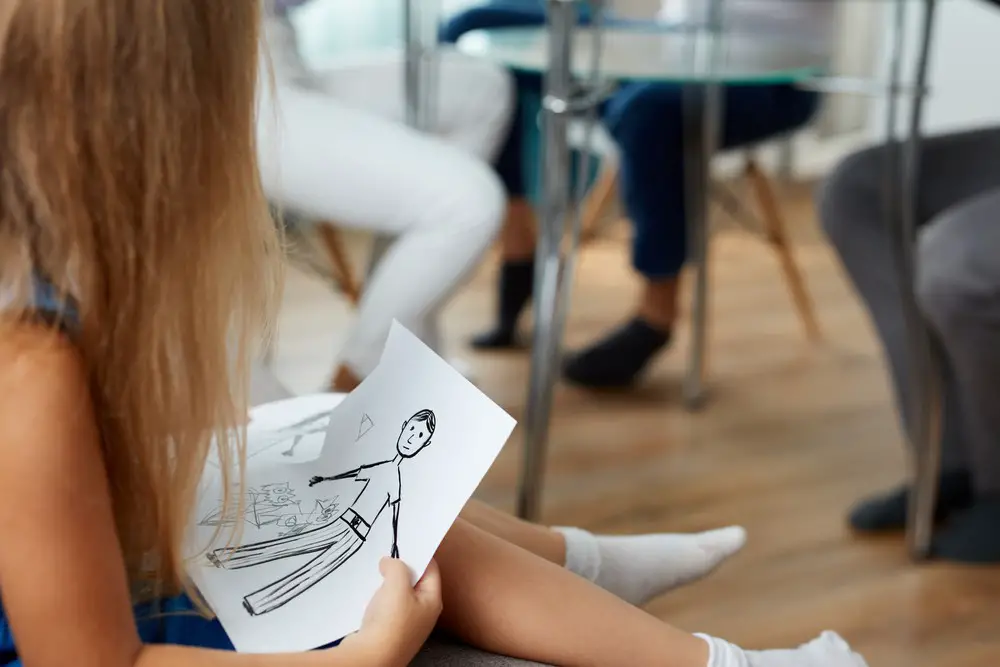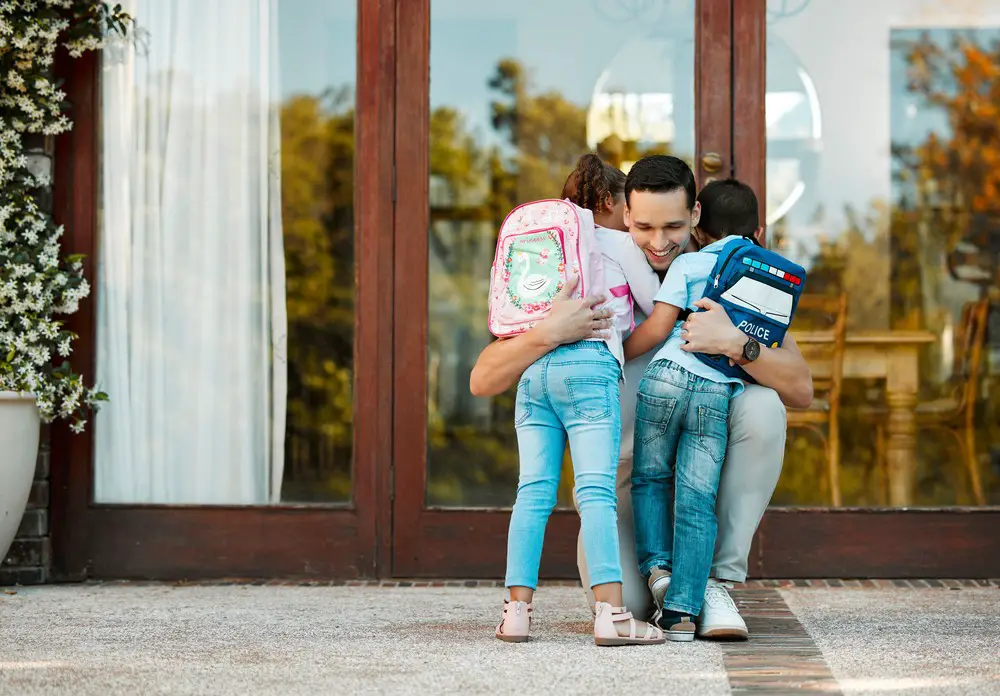As a BetterHelp affiliate, we receive compensation from BetterHelp if you purchase products or services through the links provided
Reunification therapy is a therapeutic process to strengthen the bond between parents and children following a high-conflict divorce or separation. A judge often orders this therapy to repair the relationship after intense disputes and disagreements have occurred throughout the parents’ legal battle. While reunification therapy can be an effective solution for many families, there are instances where it may not yield the desired results, failing the therapy.
When reunification therapy fails, it can exacerbate existing family problems, leading to heightened tension and emotional distress among all members. It may become even more challenging for families to get along with one another and can contribute to further miscommunication, building resentment and animosity. Deterioration in relationships can also occur due to ongoing conflict or abuse within the family dynamic, undermining the efficacy of the therapy and placing the child’s well-being at risk.
The failure of reunification therapy can be attributed to various factors, including persistent hostility in the family environment, lack of cooperation from the child or parents, and a failure of professional support. Understanding the causes and implications of failed reunification therapy is crucial to support best the children and parents involved.
Key Takeaways
- Reunification therapy aims to repair parent-child relationships after high-conflict divorces and separations.
- Failure of reunification therapy can intensify family problems, leading to increased tension and emotional distress.
- Various reasons can contribute to the failure of reunification therapy, such as persistent hostility or lack of professional support.

The Concept of Reunification Therapy
Reunification therapy is a type of family therapy designed to help repair and strengthen parent-child relationships that have been damaged or strained due to various reasons, such as divorce, addiction, or mental illness. It integrates different empirically based methods to address the specific challenges families may face during the reunification process.
In this therapeutic process, emphasis is placed on co-parenting work, which aims to improve communication and collaboration between separated or divorced parents for the child’s benefit. Through counseling sessions, families can develop the necessary skills to navigate new circumstances and foster a stronger bond between the parent and child.
As you engage in reunification therapy, it is essential to remember that this process can be challenging and takes time. Patience and dedication are crucial components to ensure the success of the therapy, as well as the willingness of all parties to participate openly and honestly. With the support of a skilled therapist, your family can unlock the benefits of reunification therapy and move towards a healthier, more loving bond.
Circumstances Leading to Reunification Therapy
Reunification therapy is often utilized when conflict, estrangement, or parental alienation has led to a severed or damaged relationship between a parent and their child. This therapy aims to repair and restore the relationship, allowing for better communication and understanding between both parties.
In cases where parental alienation is present, it’s crucial to address this issue effectively, as it can have long-lasting and damaging effects on the child, the alienated parent, and their relationship.
On the other hand, estrangement may result from various factors such as differing values or personal beliefs, abuse or neglect, or a significant life event that strains the parent-child relationship. In some cases, these estrangements are initiated by the child, while in others, the parent may be the driving force behind the rift.
Court orders may come into play when reunification therapy is deemed necessary. Typically, these orders result from legal disputes surrounding custody, visitation, or other contentious issues involving children. Court-ordered reunification therapy seeks to resolve these conflicts by providing a safe, neutral space for the family to work through the difficulties and strive for a healthier relationship.

When Reunification Therapy Fails
When reunification therapy fails, it can be a disheartening experience for all involved. Despite the therapist’s best efforts, some families may face obstacles that can’t be overcome. In these instances, the consequences can be significant for both the child and the parents.
Failed therapy often results from resistance by either the parent or the child, which can greatly reduce the chances of success. Both parties must be open and willing to participate in the process for the therapy to be effective. If one or both parents are uncooperative, the therapist may have difficulty helping the family mend their relationship.
In cases where the child refuses to participate in reunification therapy, the outcome can be especially challenging. The therapist may opt to limit or stop meetings altogether if the child expresses adamant resistance to meeting with the estranged parent. This choice can be difficult, but it is sometimes necessary to prioritize the child’s emotional well-being over forced reunification attempts.
The consequences of a failed reunification attempt can extend beyond the therapy sessions. Court involvement may become necessary, particularly if the failure affects custody arrangements or visitation rights. In such cases, the court must determine the best course of action for the child, considering their needs and any resistance they face in reconnecting with the estranged parent.
It’s important to remember that not all reunification therapy experiences will succeed. However, understanding the potential consequences and maintaining a supportive environment for the child can help lessen the emotional toll that a failed attempt may bring. Remember to remain patient and open to new approaches that may ultimately help the family overcome their challenges.
Possible Reasons for Failure
Reunification therapy can fail for several reasons, and it is essential to be aware of these factors to address them effectively. Let’s discuss some of the possible causes of failure in reunification therapy.
Resistance from Parents or Children: One common reason for reunification therapy failure is the resistance or unwillingness of one or both parties to engage in the process. If one parent is not fully committed to the therapy or actively undermines the process, success becomes challenging to achieve. Similarly, it can be hard to work if the child refuses to participate or is not open to therapy.
Mental Health Issues: Sometimes, underlying mental health issues that haven’t been addressed can contribute to the failure of reunification therapy. If a parent or child is dealing with depression, anxiety, or other mental health concerns, it may be difficult for them to engage and benefit from the therapy process fully.
Abuse and Violence: If past or ongoing abuse or violence exists within the family, reunification therapy can be more complicated and less likely to be successful. This would require additional interventions and support to ensure the child’s and parent’s safety and well-being.
Negative Beliefs and Attitudes: The favored parent’s negative beliefs and behaviors play a significant role in reunification therapy’s success or failure. If they continue to hold on to negative beliefs about the other parent or express them to the child, it can create further conflict and hinder progress in the therapy.
Lack of Functional Co-Parenting: Intense marital conflict before and after separation can contribute to inadequate co-parenting and make it more difficult for reunification therapy to succeed. In such cases, both parents may need to improve their communication and cooperation skills to support a healthier environment for their child.
Understanding these potential reasons for reunification therapy’s failure can help you and your family work through the process more effectively. Addressing these issues increases the likelihood of a successful outcome and a healthier, happier family dynamic.

Effects on Children and Parents
When reunification therapy fails, it can significantly impact both children and parents. It is important to be aware of the possible repercussions to ensure the well-being of everyone involved.
Children experiencing failed reunification therapy may suffer from various mental health issues. This can include emotional distress, confusion, and a sense of loss due to the ongoing estrangement from one parent. Sometimes, the therapy might exacerbate existing trauma, especially if the child has been abused.
In addition to emotional distress, children might develop unhealthy coping mechanisms to deal with the failed therapy. These mechanisms range from aggressive behavior to withdrawal and isolation from peers and family members. Long-term unresolved trauma and emotional distress can potentially lead to mental illnesses like depression and anxiety.
For parents, a failed reunification therapy can be a devastating experience. The rejected parent might feel powerless, rejected, and helpless in the face of a fractured relationship with their child. It is not uncommon for the parent to feel guilt or shame for not being able to rebuild the relationship successfully.
Furthermore, reunification therapy can potentially lead to re-traumatization in instances where the child has been a victim of abuse. Forcing a child to re-establish contact with an abusive parent can cause more harm than good, undermining any progress made during the therapy.
To minimize the negative effects of failed reunification therapy, it is crucial to recognize and address any potential issues early on. This might involve seeking alternative therapies, engaging in open communication, and collaborating closely with relevant professionals. By being proactive and compassionate, you can play a vital role in ensuring the child’s and parent’s well-being in these difficult circumstances.
Role of the Counselor and School in a Failed Reunification Therapy
When reunification therapy doesn’t work out as planned, you might be wondering about the role of the counselor and the school in such situations. In this section, we will look at the involvement of the counselor and the school in supporting and educating the involved parties in a failed reunification therapy scenario.
As a parent or a child involved in reunification therapy, your counselor plays a crucial role in assessing the situation and adjusting accordingly. If the therapy fails, the counselor should ideally acknowledge the reasons behind the failure and recommend alternative solutions. This might include individual therapy, support groups, or possibly a different approach to the reunification process. The counselor’s goal is to foster healthy relationships within your family. Therefore, a failed reunification therapy shouldn’t be the end – rather a chance to reassess and try new strategies.
In addition to the counselor, your school can become an essential support system throughout the process. When reunification therapy doesn’t yield the intended outcome, the school can offer the affected children academic guidance and emotional support. Educators and school counselors should be informed of your family’s situation to establish a more personalized educational plan, identify any potential stressors, and provide a safe space for the child to express their concerns and emotions.
Your school could also contribute to enhancing communication between the involved parties. By organizing regular meetings between parents, educators, and counselors, the school can ensure everyone is on the same page to determine the next steps in the child’s well-being. Moreover, the school can encourage peer support and coaching programs, connecting children and parents who share similar experiences, thus offering the opportunity to learn from each other and develop supportive relationships.
In conclusion, in situations where reunification therapy has failed, the counselor and the school still have a crucial role in the well-being of the family members involved. By remaining committed to addressing the underlying issues and offering alternative measures, the counselor and the school can continue to support your family on its journey to restore healthy relationships.
Legal Implications of Failed Reunification Therapy
When reunification therapy does not yield the desired results, litigation might become necessary to resolve disputes between parents. Typically, the court will order such therapeutic intervention as part of a custody arrangement in order to rebuild the parent-child bond. If the therapy fails, concerned parties may return to court for further evaluation and decision-making.
In such cases, the court might revise the existing custody arrangement in the child’s best interest. They may consider factors such as the willingness of the parent and the child to participate in therapy, the child’s best interest, and any evidence of parental alienation or abuse. All parties must cooperate and follow court orders, as non-compliance may lead to serious consequences.
During the litigation process, the court may call upon reunification therapists or treating psychologists as expert witnesses to provide their opinions on the progress and outcomes of the therapy. Their input can help the court make an informed decision about the appropriateness of the current visitation schedule or the need for additional therapeutic efforts.
However, it is essential to note that the court’s decision will be guided by its primary concern for the child’s best interest. So, while the court may influence certain aspects, such as therapy costs, the final verdict on custody and visitation rights will always center on the child’s welfare.
Remember, as a parent or guardian, your primary responsibility is to act in your child’s best interests, even during difficult legal proceedings. Cooperation with the court and professionals involved in the process will aid a more harmonious resolution for everyone.

The Path Forward: Healing and Reconciliation
Healing and reconciliation after a failed reunification therapy can seem daunting, but staying hopeful and taking small, meaningful steps toward rebuilding relationships is important. As you embark on this journey, keep these crucial aspects in mind.
Trust: Regaining trust is a vital part of the healing process. Take time to understand the concerns and feelings of all parties involved, and work towards establishing open lines of communication. Patience, understanding, and genuine efforts to reconnect are key components in rebuilding trust between family members.
Attachment: Developing secure attachments is integral to fostering healthy relationships. Focus on creating positive experiences and memories that can strengthen emotional connections among family members. Additionally, attempting to acknowledge and work through past trauma is essential to forging stronger bonds.
Reconnection: Gradually, you’ll want to reintroduce natural interactions and shared activities that were once a part of your family dynamics. These might include joint hobbies, celebrations, or simply enjoying time together. Building new, positive associations that can help reframe your relationships and enhance feelings of unity is essential.
Boundaries: Establishing and respecting boundaries should be a consistent element of your family’s interactions. Clearly define and communicate personal limits to ensure all members feel comfortable and emotionally safe. Practicing empathy, respect, and mutual understanding will pave the way toward a more harmonious family life.
Remember, healing and reconciling after a failed reunification therapy is not an overnight process. Give yourself and your family the time and space to make real progress. Never lose sight of the love that binds you and the desire to create a better future for everyone involved.

Bridging Broken Bonds: Recognizing When Reunification Therapy Is Needed
Reunification therapy can be a powerful tool in rekindling lost connections between family members, especially after a significant disruption or conflict. Recognizing when this therapeutic approach is needed is crucial for timely intervention and healing. Here are some signs and situations that might call for reunification therapy:
- Prolonged Estrangement: If family members have been alienated or estranged for an extended period without resolution, therapy may help break down barriers and foster reconnection.
- High-Conflict Divorce or Separation: During or after a contentious divorce, children may become alienated from one parent. Reunification therapy can facilitate the rebuilding of these relationships.
- Significant Life Changes or Trauma: Major changes like relocation or losing a family member can strain relationships. Therapy can support the family in adjusting to the new circumstances.
- Refusal to Communicate: If one family member refuses to communicate or engage with another, this could signal a deeper problem that therapy can address.
- History of Abuse or Neglect: If there has been a history of abuse or neglect, and both parties are committed to healing, reunification therapy must be approached with caution and under the guidance of a specialized therapist.
- Legal Mandate: In some cases, courts may order reunification therapy to facilitate the restoration of a parent-child relationship.
- Ongoing Conflict and Hostility: Persistent conflict and hostility without resolution may call for professional intervention to mediate and guide the healing process.
- Child’s Emotional Distress: If a child shows signs of emotional distress or behavioral issues due to the severed relationship with a parent or sibling, therapy might be a solution.
- Multiple Failed Attempts at Reconciliation: If family members have tried and failed to reconcile independently, professional guidance may be required to navigate complex emotional landscapes.
- Professional Recommendation: Sometimes, other therapists, counselors, or legal professionals may recognize the need for reunification therapy and recommend it as part of a broader treatment plan.
- Mutual Desire to Reconnect: A genuine, mutual desire to rebuild the relationship is an essential factor. Both parties must be willing to engage in the process to succeed.
Reunification therapy is not a one-size-fits-all solution, and it requires careful consideration and planning. Working with a qualified professional who can assess the unique circumstances and tailor the therapy to the family’s specific needs is essential. By recognizing when reunification therapy may be beneficial, you can take the first step toward healing and restoring those invaluable familial connections.
Navigating the Healing Path: Tips to Make the Most of Reunification Therapy
Reunification therapy can be valuable in rebuilding and strengthening the bond between estranged family members. However, it requires effort, openness, and collaboration from all involved. Here are some tips to make the most of this therapeutic process:
- Embrace Open Communication: Honesty is essential. Encourage open dialogue where everyone feels safe to express their feelings and concerns.
- Set Clear Goals and Expectations: Understanding what you want to achieve through therapy can guide the process. Communicate your goals with the therapist and family to ensure everyone is on the same page.
- Cooperate with the Therapist: The therapist is a neutral party trained to facilitate healing. Cooperate and trust their guidance, even when the process feels challenging.
- Respect Boundaries: Recognize and respect the emotional boundaries of all family members. Rebuilding trust takes time, and pushing too hard can be counterproductive.
- Commit to the Process: Reunification therapy is not a quick fix but a gradual process. Commit to attending all sessions and doing the necessary work between appointments.
- Build Trust through Consistency: Consistency in words and actions helps rebuild trust. Follow through on promises and demonstrate reliability.
- Use Empathy and Understanding: Empathizing with each other’s feelings can bridge gaps. Try to see things from the other person’s perspective, even if you disagree with them.
- Avoid Blame and Accusations: Focus on the present and future rather than dwelling on past wrongdoings. The blame game can derail progress.
- Monitor Progress and Adjust as Needed: Keep track of progress, and don’t hesitate to adjust strategies if something is not working. Regular check-ins with the therapist can be beneficial.
- Seek Additional Support if Needed: If significant issues continue to block progress, don’t hesitate to seek additional professional support or consult with a specialist.
Reunification therapy is a journey that requires patience, resilience, and determination. Implementing these strategies can pave the way for a more fruitful and harmonious relationship, turning the page on a challenging chapter in your family’s life.
Frequently Asked Questions
What are the alternatives to reunification therapy if it fails?
If reunification therapy doesn’t work, other options remain to explore. Some alternatives include individual or group therapy for family members to address specific issues or conflicts and mediation to help resolve disagreements. You may also want to look into specialized therapies that address the unique needs of your family situation.
How can families cope with unsuccessful reunification therapy?
Coping with unsuccessful reunification therapy can be challenging for families. Communicating openly, acknowledging difficulties, and maintaining a positive attitude is important. Seeking support from friends, family, or professionals like therapists, counselors, or support groups can also be beneficial in navigating this situation.
What role does the court play when reunification therapy fails?
When reunification therapy fails, the court may decide to take further action, such as ordering a child custody evaluation or assigning a guardian ad litem to represent the child’s best interests. The court may also set new visitation or custody arrangements based on what is best for the child and family.
Can a different therapist be considered if reunification therapy doesn’t work?
Yes, a different therapist can be considered if reunification therapy isn’t successful. Sometimes, the therapeutic relationship isn’t a good fit, or a therapist with specialized expertise may be better suited to address your family’s unique needs. It’s worth discussing with your current therapist and seeking recommendations for other professionals better equipped to help.
Is there any follow-up process after failed reunification therapy?
After a failed reunification therapy, the follow-up process will depend on the situation and the involved parties. Communication between family members, therapists, and the court is necessary to determine the next steps. Follow-up may include pursuing alternative therapies, receiving individual support, or carrying out court mandates to ensure the best outcome for the child and family.
What strategies can parents implement when reunification therapy is not successful?
If reunification therapy isn’t successful, parents can still take steps to improve the situation. Focus on maintaining open communication with your child and ex-partner throughout the process. Encourage honest discussions about feelings, needs, and concerns, and consider co-parenting strategies that foster a healthy relationship. Additionally, support your child’s well-being by maintaining routines, offering reassurance, and staying actively engaged in their life.
A Personal Struggle: Navigating Reunification Therapy
I’m Jacob Maslow, a person deeply committed to mental health, personally and professionally. As someone who takes Lexapro to manage my mental well-being and has extensive experience with therapy, I’ve seen firsthand the challenges and triumphs associated with the therapeutic journey.
But perhaps one of the most heart-wrenching and complex situations I’ve faced involves my own family. My ex-partner, who suffers from severe narcissism, has consistently alienated our children from me and refuses to cooperate with court-ordered shared custody. A recent attempt at reunification therapy seemed promising at first. Still, when the therapist convinced our children to renew our relationship, my ex canceled further appointments, driving a wedge between us.
My battle has been ongoing for years, filled with countless refusals to comply with court orders, broken promises, and complete obstruction of communication with my children. Once enjoying a close relationship with them, I now find myself constantly struggling to reconnect, taking long walks every day to clear my head from the pain of their absence.
Yet, I find solace in writing articles about mental health and narcissism, hoping to help others with similar challenges. I intend to empower those facing narcissistic partners and mental health battles to realize they are not alone. Through my words and insights, I want to convey that anyone can overcome mental health issues.
Furthermore, my legal site aims to assist others with a spouse refusing to comply with court orders and experiencing the heartache of having their children weaponized against them rather than co-parented. The journey is complex and fraught with difficulty, but with empathy, understanding, and determination, I believe we can find a way through.
- How to Transform a Home’s Patio Space into a Relaxing Space - March 23, 2025
- 5 Strategies to Use a Cell Phone to Help Manage Your Stress - March 23, 2025
- 4 Ways to Use Measurements to Create a Relaxing Sleep Space - March 23, 2025
This site contains affiliate links to products. We will receive a commission for purchases made through these links.



